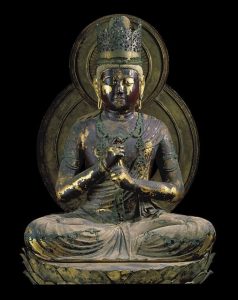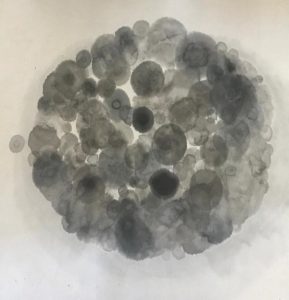Long ago, I was an art student, then a teaching assistant, and then a professional artist. It seems funny to say that one was an artist because creative propensities usually never die, it’s just that we stop feeding them. That is what has happened to me. My work and my writing have a lot to do with meditation, death and dying, issues around euthanasia and suffering, and teaching the essential tenets of the Buddhadharma to children and adults alike. But lately, I have returned to the experience of art-making out of pure need and a desire to work with color and composition on paper, to express some stuck feeling, perception, and sensation.
I recently attended the opening of a group show at the Woodstock Artist Association & Museum, and I was struck by the paintings of Kelsey Renko, a newly graduated MFA student. Her work is bold, expressive, and joyful, even exuberant. Yet, on further observation, her paintings also work with ideas around the body, feelings, relationships, and personal path that speak to me in a deep way. Those of us on the path of the Buddhadharma, meditation, and the five precepts often find ourselves wrapped up 24/7 in our practice and our offerings to the community.
Of course, this is excellent; this is the model my teachers and their teachers laid out before them. This feels, at the end of the day, like satisfaction. However, as a modern human it is easy to spill over into dualistic ways of being or become too narrow in our forms of experience and expression. For this and many other reasons, I find myself desperately drawn back to the page, to colorful instruments of art-making, and the need to express something purely original. However unimportant or unmanaged, art can serve as simply a release from the emotional, nervous, and karmic systems that we embody outward into the universe, whether on the page or in three dimensions, as performance art, music, poetry, or countless other forms of creative expression.
In months and years past, I have interviewed notable Native American artists, and I will continue to do so, as I feel very passionately about experiencing and promoting their work. Yet, from time to time, I may also showcase the work of an artist who simply speaks to me. We are modern practitioners steeped in a complex world of suffering, interconnection, and political dramas, including Dharma politics. I believe at the heart of why we seek to better our world is in part—on the relative level—to enjoy what it means to be fully human!
I’ve written about this before, but I find it important to re-emphasize that the purpose of ultimate-level enlightenment, realization, or waking up is deeply connected to the relative-level experience of being an embodied human in community. This is, at least, the Vajrayana perspective. The simultaneity of path and fruition, now and then, relative and ultimate. One way to do so is to recognize our present experience of joy, as well as the observer, and the wish for that joy to infuse all sentient beings, that fleeting joy could merge with stable joy and a vast view.
Art-making is a form of meditation and a therapeutic mode to uncover unmetabolized emotions, thought patterns, and past experiences, and even to redraw synaptic highways and form new ones. To literally re-create ourselves through our creative expression and our communal sharing of these expressions. We need not produce polished masterpieces that endure for all time. As live music and performance are temporary, art of all kinds is temporary expression. We might, then, actually burn or recycle or bury—in eco-sound ways—a drawing, for example, in an acknowledgment of the impermanence of all creations.
Last weekend, I joined some new friends in experiencing the music of John Batiste at Tanglewood. The concert was a joyful and vibrant celebration! Perhaps especially on the heels of last week’s so-called presidential debates. I sang along, danced, and enjoyed it all rather than take any photos or videos, or check messages during those three hours. This is not some kind of virtue-signaling on my part, rather an acknowledgment of how much my own nervous system needs a break from screens and instantaneous connection.
Being surrounded by 15,000 happy fans of John Batiste and his exquisite musical group, I was able to forget about my phone even though I was surrounded by people taking photos and videos and holding them aloft in the style of lighters in previous decades lit in unity at a concert.

I work with young children and teach meditation. Even when I teach graduate students, I am highly aware that there are always screens in the room and a kind of knee-jerk impulse on all our parts to check those screens, even when we are already on a Zoom screen together! It’s comical but also deeply tragic. Educational researchers have known for a decade the detrimental effects of screen time, emissions, and their impacts on attention, relationships, and self-worth development. I grieve for whatever is to come with potential further dependence and addiction to screens and devices.
When I imagine having a conversation with Shakyamuni Buddha at this point in our civilization’s development, I wonder if he—or she, or they—would raise an eyebrow about our lack of view and our incapacity to hold many viewpoints at once. If, in fact, we still investigate the world using our actual six senses. In a parallel universe, I would love to make a satirical yet deep and meaningful short film about Jesus and Buddha, Allah and Sarasvati, and as many gods, goddesses, saints, and wisdom beings together in a coffee shop. They’d be chatting about the state of things, deeply enjoying the flavor of the coffee or tea, the intensely beautiful array of artwork on the walls, a fellow playing live piano in the background, and the smiles of the baristas as they shared conversations with their customers.*

To me, it is a very worthwhile endeavor, even if portrayed in fiction rather than real life—whatever that difference is now—to juxtapose the insane amount of time, energy, and brain cells we spend living in the virtual world, while the extreme beauty and suffering of the actual world swirls all around. The messy, intertwined, human-animal-insect-environment-and-weather world is still what interests me most. More than ever, the smell of soil, of coming rain, or my neighbor baking a peach cobbler, mesmerizes me. The sound of water or a child crying, a sensation of cool air on my skin, or a friend’s hand squeezing mine, the simplest but most profound sensations we humans can notice, enjoy, and reflect on.
How amazing this is! I do not give much thought to artificial intelligence, aside from a vague feeling of doom, because it seems just another great distraction from our natural humanity—and the natural and more-than-human realms—with all its foibles and ordinariness. I hope you will feel inspired to walk out into your environment, urban, suburban, rural, or whatever it may be, and experience fully its great beauty, interest, and sensory pleasures in the natural or human-made environment. May you drink in that enjoyment and dedicate the merit for the bliss and awakening of all sentient beings.
* Christ and Buddha meet at the Coffee Shop (Substack)
See more
Kelsey Renko (Instagram)
Related features from BDG
Myth in the Making: Celebrating American Artist Burton Kopelow’s 100th Anniversary
Book Review: Summoned by the Earth: Becoming a Holy Vessel for Healing Our World
Indigenous Art Matters – The Bold, Contemporary Work of Artist Gregg Deal
Abstract Meditations and Artistic Contemplation, with Françoise Issaly
Leonard DeLonga – Artist, Teacher, Bodhisattva


















